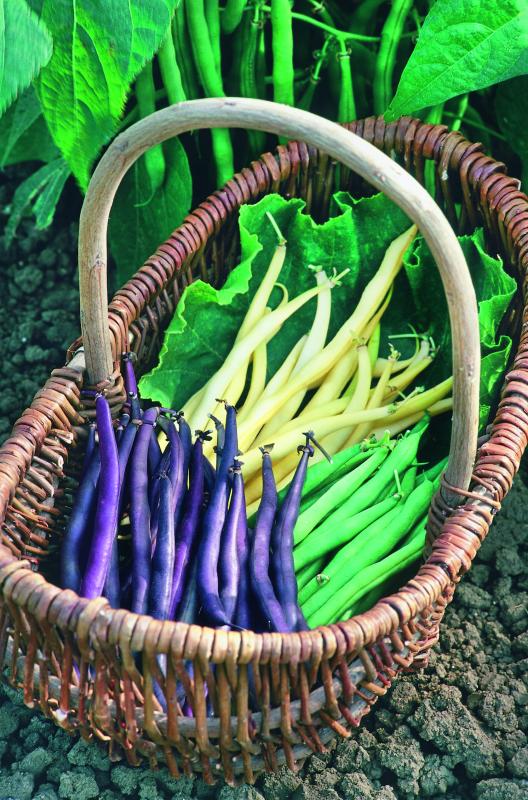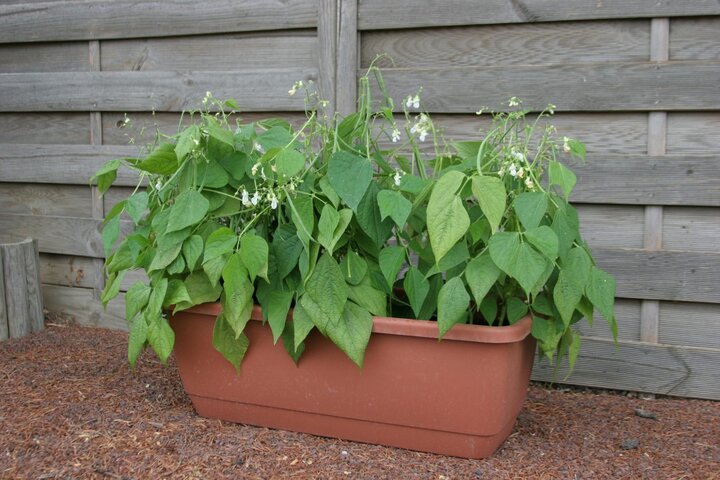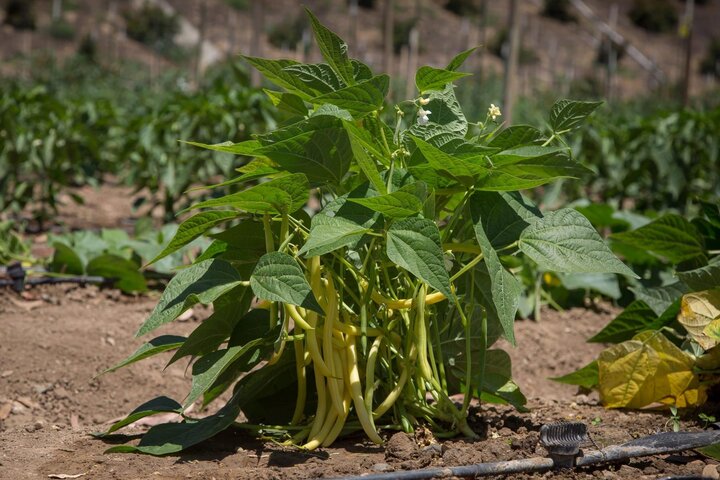Sarah Browning, Nebraska Extension Educator

'Mardi Gras Blend' beans from Seeds by Design. Image from the National Garden Bureau
There are many species of beans in cultivation around the world, yet it is the common garden bean Phaseolus vulgaris that takes on celebrity status as National Garden Bureau’s vegetable focus for 2021.
One of the earliest cultivated plants, garden beans can trace their beginnings to Central and South America. Vining or climbing beans were an original member of the “Three-Sisters”– a companion planting of the first domesticated crops of maize, winter squash, and climbing beans. These became the three main agricultural crops used for trade and food for Native North Americans.
Green beans were once referred to as string beans due to the long fibrous thread along the pod seams. The first stringless green bean was developed in 1894 by Calvin Keeney who later became known as the “Father of the stringless bean”. Breeders continue to breed this stringless trait into modern genetics. Other desirable traits include dark green succulent pods, good bean flavor, concentrated fruit set, stress tolerance, and disease resistance.

Basic Types of Garden Beans
The common garden bean is anything but common! Green beans or ‘snap’ beans as they are also referred to come in a variety of flavors, pod shapes, sizes, and a colorful pallet including shades of green, purple, yellow, and speckled bicolors.
Bush beans are the workhorse of the garden and the mainstay in the kitchen. Bush beans are compact and fit well into both small garden patches or patio containers fitted with cages.
Pole beans with their vining habits and can be trained up poles, trellises, netting, or supportive structures such as a teepee. With proper support pole beans can also be grown in containers.
Filet beans or Haricots Vert (French green beans) are distinguished by elegant ultra-slim pods. Due to their delicate appearance, Filet beans are gaining in popularity with foodies and chefs. Filet beans come in both bush and pole bean types.
Dried or shelling beans are grown for their edible seeds rather than edible pods. Pinto beans, kidney beans, and black beans fall into this category.
Varieties to Try

Pole Beans
- Seychelles – Seven to nine-foot vines produce multiple crops of 5-6″ long stringless pods with excellent flavor. Fast-growing and early-to-produce crisp delicious pods. 2017 AAS Winner.
- Kentucky Blue– Produces 6-8″ dark green pods on six-foot vines with outstanding Blue Lake flavor. Can be harvested all season long. 1991 AAS Winner.
Bush Beans
- Mascotte – A gourmet compact variety perfect for today’s small space gardens. Produces long slender pods that stay above the foliage for easy harvest. 2014 AAS Winner.
- Desperado – Heat and stress tolerance makes this an easy to grow and high yielder of long straight 5″ dark green pods.
Specialty Beans

- Roma II – A Romano or Italian flat bean that produces an abundance of wide, flat 5″ long pods with a distinctive rich, intense, beany flavor. Bush type habit.
- Amethyst Purple – A French filet bush bean that produces beautiful violet-purple, long slender stringless pods on compact plants suitable for containers and raised beds.
- Gold Rush – The gold standard for yellow wax beans, Gold Rush produces clusters of straight 5-6″ long yellow pods. Pods hold well on the bush and are versatile in the kitchen.
Garden Bean Growing Tips
- Beans are warm-weather vegetables and are best planted after soil temperatures reach 70F.
- Avoid sowing too early in the season. Cool wet soils can lead to rot.
- Beans thrive with at least eight hours of daily sun, moderate fertility, and well-drained soil.
- Beans have shallow roots, weed carefully to prevent damage to the root system.
- Mulch the soil around the bean plants; consistent moisture results in the highest quality harvests.
- Quick to mature; harvests can begin 50-60 days after sowing.
- Bush beans typically grow 12 to 24 inches tall and produce harvests for about 3 weeks.
- Succession sowing of bush beans every 2-3 weeks will produce delicious beans all season.
- Pole beans have a long harvest season, generally lasting about six to eight weeks.
- Harvest frequently to encourage pod production.
- Pole beans can quickly grow a lush privacy wall around porches or patios.
- Create a living fort or teepee with pole beans for a fun play space.
- Yellow wax beans lack chlorophyll and will retain their beautiful golden color when cooked.
- Purple beans contain anthocyanins (the purple pigment) that disappear when beans are cooked.
Garden Bean Harvesting Tips
- A good indication of when to harvest is to reference the days to maturity for the specific variety. Pick green beans when pods are young and tender, just before the seeds begin to swell. Beans will “snap” when you bend and break them. If they are immature, they won’t snap!
- Fresh unwashed green beans should remain fresh for up to a week when stored in a reusable container or plastic bag in the refrigerator.
- Versatile in culinary preparation, garden beans can be eaten raw, steamed, boiled, stir-fried, grilled, or baked. For the best eating experience, cooked green beans should still have a crisp texture and an appetizing bright green color.
- Green beans pair well with a variety of herbs, spices, and flavors.Parsley, rosemary, sage, savory, thyme, a splash of lemon juice, or a pat of butter are very popular additions to bean dishes. You can’t go wrong with the simple addition of garlic and onions. There are some who swear green beans cry out for bacon bits or a dollop of bacon grease added to the cooking pot.
- Green beans are bred for eating fresh or processing/preserving. Some varieties are well suited for both. Processing green beans are better able to retain their beautiful color and texture for canning, pickling, and freezing. If you look forward to gifting out jars of pickled green beans, a processing green bean will yield you the best results.
For more information on this year's featured plants, visit the National Garden Bureau, which recognizes and thanks Syngenta US as author and contributor to this fact sheet.
Images from the National Garden Bureau.
- 'Mascotte' beans produce compact plants ideal for patio containers, window boxes or garden beds.
- Pole beans grow best when given a structure to climb. This makes harvesting easier, too!
- 'Custard' beans by Seminis Seeds produces long, beautiful, bright yellow pods.
Search Our Archive
Associated Video
Garden Beans
Nebraska Extension Educator Terri James discusses various beans for the garden.